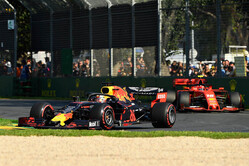


06/04/2019
NEWS STORY
 In the wake of a disappointing 2018 Australian Grand Prix which featured just a handful over overtakes and which followed the revelation that overtaking in 2017 was 50% down on the previous year - a stat that Pirelli no longer provides, though it's not clear why - the sport got to work on a set of aero rules for 2019 aimed directly at increasing the chances overtaking by allowing cars to follow one another more closely.
In the wake of a disappointing 2018 Australian Grand Prix which featured just a handful over overtakes and which followed the revelation that overtaking in 2017 was 50% down on the previous year - a stat that Pirelli no longer provides, though it's not clear why - the sport got to work on a set of aero rules for 2019 aimed directly at increasing the chances overtaking by allowing cars to follow one another more closely.
Simplified front wings featuring less architecture than before, revised bargeboards and brake ducts, not forgetting a similarly simple rear wing, were all intended to improve the show.
The very nature of the Melbourne track means that it was hard to get a picture of the impact of the new rules, and while there was plenty of passing in Bahrain - aided by the addition of the third DRS zone - it is still unclear as to exactly how effective the new rules will prove.
Talking to the FIA's AUTO magazine ahead of the Bahrain race, the governing body's Head of Single Seater Technical Matters, Nikolas Tombazis, expressed his confidence in the new regulations, claiming that some events will see overtaking increase by 50%.
"We were not expecting a huge delta in Australia, which is a difficult track at which to overtake in any case," he admits. "Some simulations were showing a 10 per cent increase of overtaking, assuming a similar evolution of a race, of course.
"In other races the same simulations expect a more sizeable increase, possibly to the tune of 50%," he continued. "That's the feedback we've had so far, but it will really only become clear as we progress through the season.
"We weren't expecting miracles in round one at Australia, but generally we are expecting a step in the right direction as far as aerodynamics are concerned.
"Looking at the cars in testing and seeing certain solutions there are undoubtedly a few things we might have done slightly differently in the rules," he admits, "but that's always the case. Overall, I'm pleased with the direction of the aerodynamic characteristics.
"I certainly don't think we have arrived at the final destination point and we can never sit back and say, 'OK, it's all fine'," he adds. "However, I think that if we hadn't gone through this process and we were sitting here writing the 2021 rules we would be in a much weaker position.
"For what we are trying to achieve, 2019 has been a very useful exercise and has lessened the wake effect. Whether this season proves to be an exciting championship depends on how closely matched the teams are. And like everyone else, that's something I'm very anxious to see."